 Voyenno-morskoy flot Rossiyskoy Federatsii: 370 active ships, 160K personnel 2023
Voyenno-morskoy flot Rossiyskoy Federatsii: 370 active ships, 160K personnel 2023The worlds’s third largest Navy:
The naval arm of the Russian Armed Forces today is the world’s third-largest naval force. It is the continuation of both the traditions of the Imperial Navy which existed since 1696 and inheriting the military-industrial complex of the Soviet era, which for the duration of the Cold War, was the world’s second-largest Navy in 1990. The Russian Navy’s present iteration was formed in January 1992, succeeding the Navy of the Commonwealth of Independent States, itself briefly succeeding the Soviet Navy after the fall of the Soviet Union by late December 1991, also signalling the end of the Cold War.

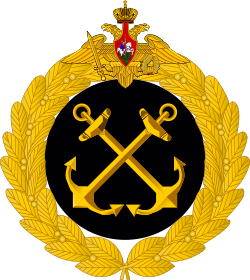 However as of the summer of 2025, new military threats emerges signalling, notably for the west, the end of the “dividends of peace”. The present article is thus directed at presenting the contemporary Russian naval Capabilities, recent deployments in 1992-2025 and future plans. With the USN still active in the western theatre but more and more focused on the Chinese PLAN and constant threats of invasion of Taiwan, a world war three will probably have the USN split in two like in WW2, but its current size meant probably three quarters of its assets will be directed in the Asian theatre alone, leaving the EU and NATO dealing with the threat posed by the Russian Navy.
However as of the summer of 2025, new military threats emerges signalling, notably for the west, the end of the “dividends of peace”. The present article is thus directed at presenting the contemporary Russian naval Capabilities, recent deployments in 1992-2025 and future plans. With the USN still active in the western theatre but more and more focused on the Chinese PLAN and constant threats of invasion of Taiwan, a world war three will probably have the USN split in two like in WW2, but its current size meant probably three quarters of its assets will be directed in the Asian theatre alone, leaving the EU and NATO dealing with the threat posed by the Russian Navy.
History: From the fall to a Rebirth
At the fall of the Soviet Union in 1991, the Soviet Navy (Советский Военно-морской флот, VMF SSSR) was one of the most powerful naval forces in the world — second only to the United States Navy in terms of global reach, nuclear capabilities, and tonnage. Its personnel was estimated around ~500,000 (including naval infantry and aviation) for 1,300 vessels including submarines, cruisers, destroyers, frigates, and patrol boats. The core of its strategy laid in the submarines, with over 200 active including c60 nuclear-powered ballistic missile submarines or SSBNs alone for deterrence and unique classes of SSGNs (cruise missile submarines) completed by a wide array of SSNs and conventional submarines of many classes.
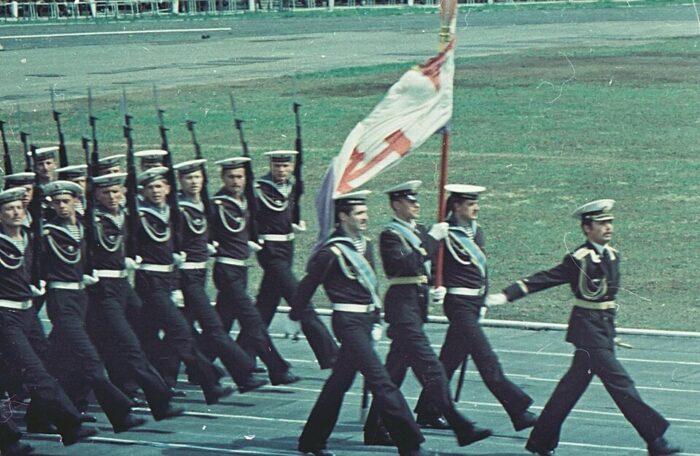
Naval Infantry red square parade, 9 May 1989.
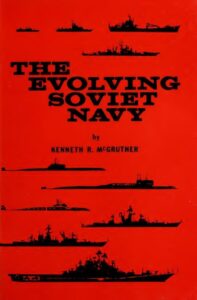 There was in support a solid Naval Aviation complement, between aircraft and helicopter on major surface combatants, to patrol flying boats and land-bases bombers, in total over 1,200 naval aircraft (fighters, bombers, reconnaissance, ASW). Let’s cite the Tu-22M3 “Backfire” bombers (long-range anti-ship strike), Yak-38 VTOL fighters (on Kiev-class carriers) and MiG-29, Su-27 in late integration stages for the upcoming Kuznetsov class carriers.
There was in support a solid Naval Aviation complement, between aircraft and helicopter on major surface combatants, to patrol flying boats and land-bases bombers, in total over 1,200 naval aircraft (fighters, bombers, reconnaissance, ASW). Let’s cite the Tu-22M3 “Backfire” bombers (long-range anti-ship strike), Yak-38 VTOL fighters (on Kiev-class carriers) and MiG-29, Su-27 in late integration stages for the upcoming Kuznetsov class carriers.
Its organization was as follows:
The Northern Fleet (Severomorsk) was the primary base for nuclear deterrence submarines, they operated in the North Atlantic and Arctic
The Pacific Fleet (Vladivostok) was aimed at Japan and China, and the second-largest fleet with regular Asia-Pacific operations and cooperation exercises
The Baltic Fleet (Kaliningrad/Baltijsk) was tasked of Coastal defence and strategic gateway to Europe, answering NATO assets.
The Black Sea Fleet (Sevastopol) was its Middle East actionable force, and NATO southern flank threat, operating in the Black and Mediterranean Seas
The Caspian Flotilla was limited to inland sea operations. There were also sizeable riverine assets.
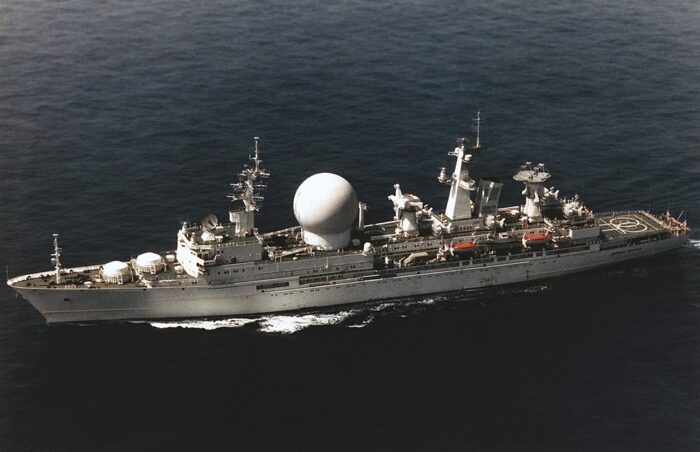
Distinctive assets of the Soviet Navy:
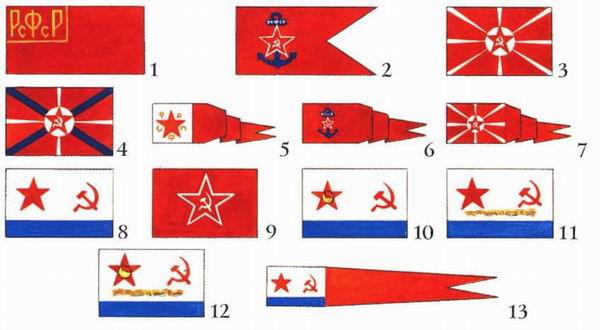
Russian/Soviet flags 1919-1992
The Soviet Navy’s Strategic Capabilities came from the presence at sea of a dozen Strategic Missile Submarines (SSBNs) of the Delta I, II, III and IV class (Project 667BDRM/BDR) and six Typhoon-class (Project 941), the largest submarines ever built, armed with long rage SLBMs such as the R-29 Vysota, MIRVed. The older Yankee class were entering the reserve.
The SSGNs were a unique asset unique to the Soviet Navy, submarines dedicated to launch large cruise missiles. They were the designated “carrier killers”. The most impressive were four Oscar-class cruise missile subs (Granat and P-700 “Granit” missiles), with a “zoo” of other classes, the recent Charlie, the older Echo II and the diesel-powered Juliet.
The attack submarines fleet comprised the state of the art Akula-class, followed by Sierra and Victor class, and even 1s Generation November class now in reserve. The titanium-built Alfa-class, in the late 1960s a technological prowess (world’s fastest and deep-diving) had been retired due to maintenance issue. The Victor III, Sierra (also in titanium) were more silent than earlier classes, and the Akula caught up with western designs.
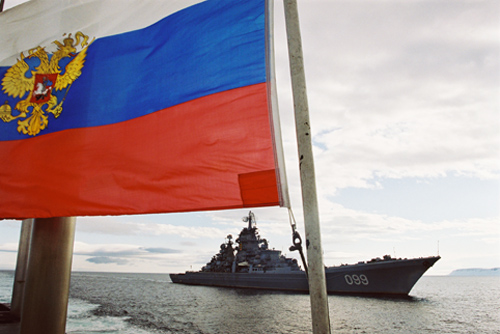
The surface Fleet also comprised impressive assets, such as the 4 Kirov-class nuclear-powered battlecruisers, without equivalent in NATO and which forced the Reagan Administration to reactivate and modernize at great cost the four Iowa class battleships. This was completed by four “carrier-killer” cruisers, the Slava-class, and a menagerie of specialized cruisers, the Kara (ASW), and Kresta I, II (AA/W), with the old Kynda in reserve. The core of the Soviet missile destroyer force rested on a trio, the Kashin, Sovremenny and Udaloy class destroyers, around 60 ships. There were also in reserve older gun-armed and hybrid designs, the Krupny/Kanin, and Kotlin/Kildin.
But of course the Soviet Union’s best assets, at least on paper, were its air projection vessels, the then Admiral Kuznetsov in construction, first dedicated Soviet aircraft carrier, and class leader, but also the four hybrid “heavy cruisers” of the Kiev class and elderly Moskva class helicopter cruisers.
Lower on the list were an immense fleet of frigates and corvettes. The most recent and potent for the USN being the Krivak class. There were also considerable fleets of patrol boats and fast attack crafts, such as the Komar and Osa class.
The Amphibious fleet was also quite large and only inferior to the USN. There were also quite unique assets such as the Ekranoplanes (3 amphibians, 1 missile carrier, experimental) alongside fleets of hydropters and hovercrafts, including, for the latter, the largest assault hovercraft ever built.
This was a respected, capable fleet, for which NATO worked hard to answer, day and night, for decades.
Cold War Missions:
The Soviet Navy was designed not primarily to control sea lanes like NATO navies, but to deny access to enemy naval forces (especially U.S. carrier groups), protect SSBN “bastions” in the Barents Sea and Sea of Okhotsk, deploy long-range missile systems from air, sea, and submarine platforms, and support global socialist allies (Syria, Cuba, Vietnam, Angola, etc.).
Post-Soviet Collapse Impact:
After 1991, the Russian Navy inherited the bulk of the Soviet fleet, but funding collapsed, so many ships rusted in port or were scrapped. Training and readiness plummeted, Shipbuilding stagnated for over a decade. The Black Sea Fleet was divided between Russia and Ukraine, causing decades-long disputes. Also, many promising platforms (e.g., Ulyanovsk-class super carrier, more Typhoons) were cancelled or abandoned.
Rebirth of the Russian Navy
In 1992, many ships were scrapped or laid up as accommodation ships at naval bases since funds were lacking not only for modernization, refit or simply proper maintenance. Naval personal were no longer paid and had to fend off taking other jobs. Even the military-industrial complex suffered from massive layoffs. The building program was essentially stopped.
Enters Sergey Gorshkov. The man was responsible for the buildup during the Soviet, and emphasised ships over support facilities, but had also retained ships in service beyond their effective lifetimes, so a reduction became inevitable. Budget reductions thus were the main cause for this retirement. In 1991 indeed, a large part of the Soviet Naval arsenal at sea was made of vessels from the late 1950s and early 1960s. The situation was exacerbated by the impractical range of the types only possible from the Soviet military-industrial complex. With full complicity of the top brass and party, the Soviet Navy in the mid-1980s, unlike the USN, was a menagerie of nearly 250 different classes of ship. By contrast, the USN only rested on 5 classes: The Nimitz class CVs, Spruance class DDs, OH Perry class frigates, Ohio and Los Angeles class subs. This made the USN logistic train, maintenance, repairs and facilities, far more leaner and more economical.
The sanction of maintaining this fleet meant the new Russian Navy needed drastic reductions. The smaller size of the federation meant global power projection was no longer the priority, but instead ensuring more traditional defensive missions, including deterrence. Large ships associated with global projections were now long longer justified other than for prestige. The Kiev-class aircraft carrying cruisers were prematurely retired as well as the incomplete second Admiral Kuznetsov-class aircraft carrier, Varyag, later sold to the PLAN by Ukraine. Funds were now allocated for the completion of ships ordered prior to the collapse of the USSR and for refits and repairs on the most recent vessels. Construction and refit times however started to stretch out extensively. One good example was the late Akula-class submarine Nerpa, under construction for fifteen years.
The storage of decommissioned nuclear submarines became a significant environmental issue. The Bellona Foundation reported details of readiness and started to coordinate international funding. Naval support bases outside Russia (Cam Ranh Bay, Vietnam notably) were gradually closed except Tartus in Syria and naval Aviation was also curtailed from 60,000 personnel, 1,100 combat aircraft in 1992 to 35,000 personnel, 270 combat aircraft in 2006. Training time also fell. In 1995 the deterrence was also impacted as the post-collapse Russian Navy was only capable of maintaining two SSBNs on patrol at any time, one for the Northern and one for the Pacific Fleet. Large, complex assets like SSGNs of the Oscar class also suffered, as shown by the loss of the Kursk during the Northern Fleet summer exercise.
As of February 2008, 44 nuclear submarines were listed, but only with 24 operational and on 19 diesel-electric submarines, 16 were operational. There were also 56 1st and 2nd rank surface combatants listed, but only 37 operational. After Kursk there was another high profile incident, the November 2008 accident on board the Akula-class Nerpa in sea trials, just before lease to India.
Things only gradually started to improve in the 2010s. In 2010-2014 Russia negotiated the purchase of four French Mistral-class LHDs, until cancelled on 3 September 2014 by French President Hollande due to the intervention in the Donbass. The ships were resold to Egypt. In 2012, President Vladimir Putin announced a plan to build 51 modern ships and 24 submarines by 2020, the largest naval plan of Russian History sine the Cold War. Of the new 24 planned submarines, 16 were planned to be nuclear-powered (SSBN/SS(G)N. It’s only by 10 January 2013, that the first of the new Borei-class SSBN, Yury Dolgorukiy, was acepted into service. Aleksandr Nevskiy followed on 21 December 2013, Vladimir Monomakh in late 2014, Knyaz Vladimir (2020), Knyaz Oleg (2021), Generalissimus Suvorov (2022), Imperator Aleksandr III (2023), and the recent Knyaz Pozharskiy this July 2025 (as it is written) with four more announced, in construction from 2021 and started in 2024. This is the top priority program of the current Russian Navy.
The other big program are the three Yasen-class nuclear attack submarines. This is completed by the trusted and economical Lada and Improved-Kilo-class conventional attack submarines. Modernization of the surface fleet is centered around six new classes of corvette and offshore patrol vessels, a new frigate class, the Admiral Gorshkov class, and new classes of amphibious ships and support vessels. With all this, the 2019, total tonnage reached 1,216,547 tonnes.
The Russian Navy’s Role, Organization and Bases
Voyenno-morskoy flot Rossiyskoy Federatsii (Russian Navy) is the naval component of the Armed Forces of the Russian Federation, designed to protect Russia’s national interests on the seas and oceans.
Its main tasks, clearly visible in the latest doctrine, are the following:
-Protecting Russia’s maritime borders.
-Strategic deterrence (including with the help of submarines with nuclear weapons).
-Supporting land operations and projecting force beyond Russia’s borders.
-Ensuring the safety of maritime navigation.
Composition
Global Strength
Surface Fleet
-1 aircraft carrier: legacy Kuznetsov (now to be announced decommissioned)
-2 battlecruisers (legacy, nuclear): Admiral Nakhimov, Pyotr Velikiy
-2 Slava-class cruiser: Varyag, Marshal Ustinov (Moskva lost 2022)
-2 Sovremennyy-class destroyer: (+2 laid up, reserve): Nastoychivy, Admiral Ushakov
-8 Udaloy I/II class destroyer: Vice-Admiral Kulakov, Admiral Tributs, Marshal Shaposhnikov, Severomorsk, Admiral Levchenko, Admiral Vinogradov*, Admiral Panteleyev, Admiral Chabanenko*
-3 Krivak (Grigorovitch sub-class) frigates: : Admiral Grigorovich, Admiral Essen, Admiral Makarov
-2 Neustrashimy-class frigate: Neustrashimy, Yaroslav.
-2 Gepard-class frigate (6 built): Republic of Tatarstan, Republic of Dagestan.
-3 Admiral Gorshkov class: Admiral Gorshkov, Admiral Kasatonov, Admiral Golovko
-9 Steregushchiy-class corvette: Steregushchiy, Soobrazitelnyy, Boikiy, Stoikiy, Sovershennyy, Gromkiy, Aldar Tsydenzhapov, Merkury, Rezky
-6 Parchim-class corvettes
-5 Bykov class Corvette
-13 Karakurt class corvette
-11 Buyan-M class corvette
-3 Buyan class corvette
-2 Bora class corvette
-20 Tarantul class corvette
-8 Nanuchka class corvette
-19 Grisha class corvette
-c40 amphibious ships
Underwater Fleet
-7 SSBN, Dolgorukiy-class (Project 955 Borei)
-5 SSBN, Delta IV-class (Project 667BDRM Delfin), 3 TBD
-7 SSGN Oscar II-class submarine (Project 949A Antei)
-5 SSN Yasen-class submarine (Project 885M Yasen-M)
-9 SSN Akula-class submarine (Project 971 Shchuka-B)
-2 SSN Victor III-class submarine (Project 671RTMK Shchuka)
-2 SSN Sierra II-class submarine (Project 945A Kondor)
-1 SSK Lada-class submarine (Project 677 Lada)
-12 SSK Improved Kilo-class submarine (Project 636.3)
-5 SSK Kilo-class submarine (Project 877 Paltus)
-1 K-239 Belgorod special operations submarine (Project 09852)
-2 Kashalot-class submarine (Project 1910)
-2 Paltus-class submarine (Project 1851.1)
-1 B-90 Sarov special operations submarine (Project 20120)
-1 Delta IV-class special operations submarine BS-64 Podmoskovye (Project 09787)
-1 Delta III-class special operations submarine Orenburg (BS-136) (Project 09786)
-1 AS-31 Losharik special operations submarine (Project 10831)
Fleets
The Navy is divided into four fleets and one flotilla, inherited from the Soviet and Imperial Navies:
The Northern Fleet
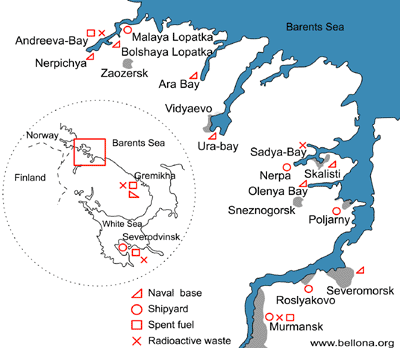
Largest and most strategically important; based in Severomorsk. The main carrier of strategic submarines.
Northern Military District, Northern Joint Strategic Command:
1 Kuznetsov-class aircraft carrier (Project 1143.5)
2 Kirov-class battlecruiser (Project 1144 Orlan)
1 Slava-class cruiser (Project 1164 Atlant)
1 Sovremennyy-class destroyer (Project 956 Sarych)
1 Udaloy II-class destroyer (Project 11551 Fregat-M)
3 Udaloy-class destroyer (Project 1155)
2 Admiral Gorshkov-class frigate (Project 22350)
1 Nanuchka-class corvette (Project 1234 Ovod)
6 Grisha-class corvette (Project 1124 Al’batros)
2 Dolgorukiy-class submarine (Project 955 Borei)
5 Delta IV-class submarine (Project 667BDRM Delfin)
2 Oscar-class submarine (Project 949A Antei)
2 Yasen-class submarine (Project 885M Yasen-M)
6 Akula-class submarine (Project 971 Shchuka-B)
2 Sierra-class submarine (Project 945A Kondor)
2 Victor III-class submarine (Project 671RTMK Shchuka)
1 Lada-class submarine (Project 677 Lada)
4 Kilo-class submarine (Project 877 Paltus)
1 K-239 Belgorod special operations submarine
2 Kashalot-class submarine (Project 1910)
2 Paltus-class submarine (Project 1851.1)
1 B-90 Sarov special operations submarine (Project 20120)
1 Delta IV-class special operations submarine BS-64 Podmoskovye (Project 09787)
1 Delta III-class special operations submarine Orenburg (BS-136) (Project 09786)
1 AS-31 Losharik special operations submarine (Project 10831)
The Pacific Fleet
Operates in the Far East; based in Vladivostok and Vilyuchinsk.
Strenght:
-Nuclear-powered ballistic missile submarines (SSBNs): 5 Borei class, 1 Delta III (+6 planned).
-Multipurpose nuclear submarines: 1 Yasen SSGN, 5 Oscar II SSGN, 4 Akula, SSN.
-Diesel-electric submarines: 3 Lada and 10 Kilo class.
-Missile cruisers: Legacy 1 Kirov class, and 1 Slava class.
-Missile destroyers: Legacy, 1 Sovremenny and 4 Udaloy.
-Frigates: 2 Admiral Gorshkov
-Corvettes: 1 Gremyashchy, 2 Steregushchiy, 10 Tarantul, 3 Nanuchka, 8 Grisha
The Baltic Fleet
Based in the Kaliningrad Oblast, covers the western borders.
(to come)
The Black Sea Fleet
Based in Sevastopol (Crimea); active in the Black and Mediterranean Seas.
(to come)
The Caspian Flotilla:
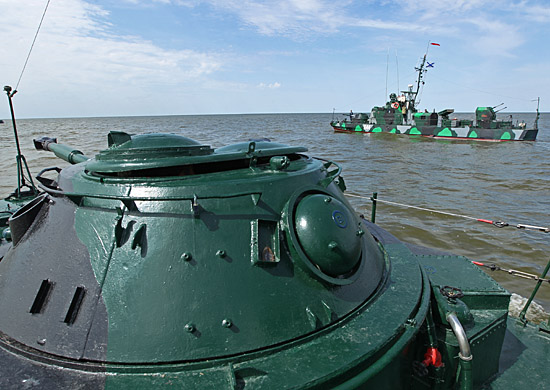
Project 1204 “Shmel” – Division of artillery boats for the protection of the Caspian Flotilla
Operates in the Caspian Sea a number of rather small units, some quite unique and reminiscent of old style monitors (like above).
Russian Ship classes: The Russian Navy operates the whole range of naval asset of an oceanic, 1st rank navy:
Small missile ships (MRK) — armed with Kalibr missiles.
Landing ships — including universal landing ships (UDC) under construction.
Naval aviation — naval aviation (manned and unmanned), including carrier-based aviation (e.g. Su-33, MiG-29K).
Current capabilities:
-Use of Kalibr cruise missiles from sea platforms.
-Conducting naval exercises in the Arctic, Mediterranean, and Pacific Ocean.
-Development of new 5th generation submarines.
-Growing presence in the World Ocean.
Nomenclature
 Admiral Kuznetsov
Admiral Kuznetsov
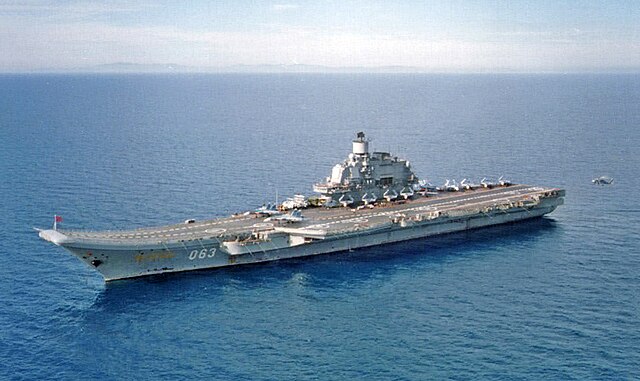
Sole member of her class completed just before the fall of the Soviet Union in January 1991, she was for long, the only aircraft carrier of the new Russian Navy, since the four Kiev and two Moskva class were deactivated. For all her career she experiences a lot of issue and made onl a few fleet deplyoments as intended, as task force command ships. Crititicized for her powerplant issues, she underwent overhaul and repairs since March 2017, but all work stopped as of July 2025. Given her age and maintenance cost, it is likely she is going to be without planned successor. The current situation however does not prioritize any carrier for the Russian Navy yet, notably given the impossibility to cross the dardanelles strait to operate in the Black sea.
 Kirov class Battlecruisers
Kirov class Battlecruisers
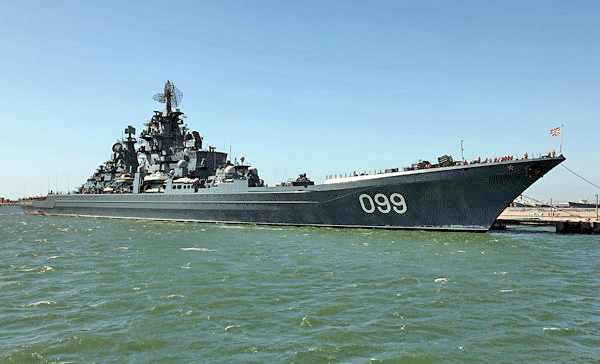
Of the crown Jewel of the “classic” surface fleet of the Soviet Uniion, these are the last two survivors. Now 40 years old, these massive prestige ships needed radical overhauls and modernizations. Both Admiral Nakhimov and Pyotr Velikiy (Kalinin Yuri and Andropov, renamed 1992) were taken in hand for such endeavour, first Pyotr Velikiy (Peter the Great), then Nakhimov, which own modernization comes to an end and likely replacing the former if fully operational, leaving just one such cruiser in operation for the foressable future. These massive ships needs no presentation, see the article for more.
 Slava class Cruisers
Slava class Cruisers
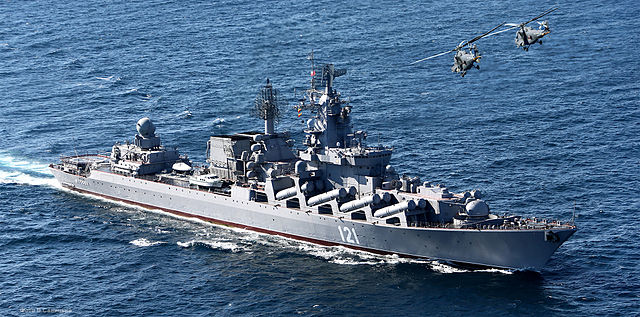
Before the loss of Moskva attacked to the black sea fleet in 2020 in the hand sof the Ukrainian, this legacy cruiser class, replacing the 1960s Kynda class as “carrier-killers” are now reduced to just two ships, Varyag and Marshal Ustinov.
 Sovremmeny class destroyer
Sovremmeny class destroyer
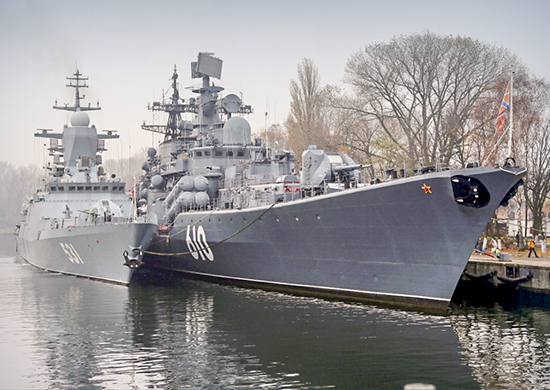
Only two Sovremennyy-class destroyer: (+2 laid up, reserve; out of a fleet of 21): Nastoychivy, Admiral Ushakov are in service today, modernized. These hulls were laid down in 1988 and they were effectively the last completed, in 1992-93. Attached to the Northern Fleet. Originally conceived in the 1970s to bring back artillery in support of amphibious operations, but the concept evolved into more versatile platforms.
 Udaloy class Destroyer
Udaloy class Destroyer
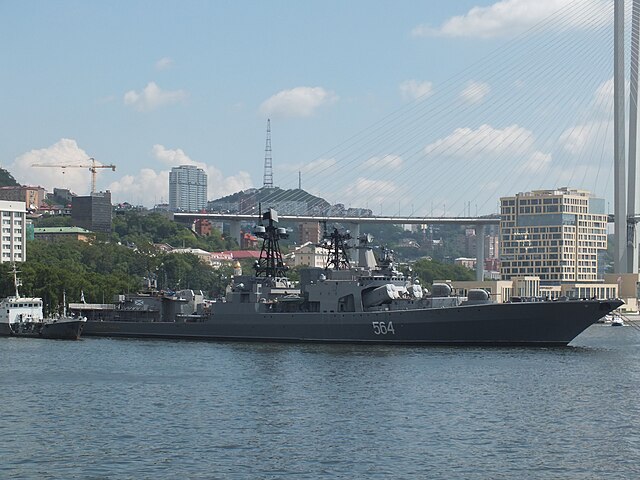
8 Udaloy I/II class destroyer (13 completed, 15 planned): Vice-Admiral Kulakov, Admiral Tributs, Marshal Shaposhnikov, Severomorsk, Admiral Levchenko, Admiral Vinogradov*, Admiral Panteleyev, Admiral Chabanenko*
These are the last Russian missile destroyers. They are distributed between the Northern and Pacific fleets. Originally designed as large ASW combatants. Modernization level is average.
 Krivak class Frigate
Krivak class Frigate
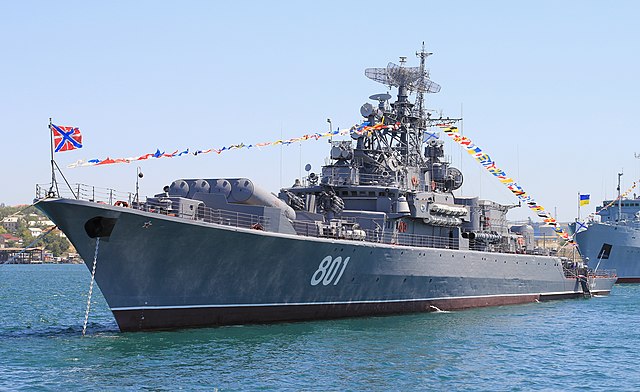
Another legacy design, the numerous Krivak class were the bedrock of the small surface fleet of the Soviet Navy in the 1980s, and for their size they packed a serious firepower, capable of anti-air, anti-ship and ASW warfare. In all, 33 frigates were built from 1975 to 1990. The Krivak, under a modernized form, is still in construction today (Admiral Grigorovich class) and exports are more important than domestic construction in today’s Russia. There are three active, Admiral Grigorovich, Admiral Essen and Admiral Makarov.
 Neustrashimy-class frigate
Neustrashimy-class frigate
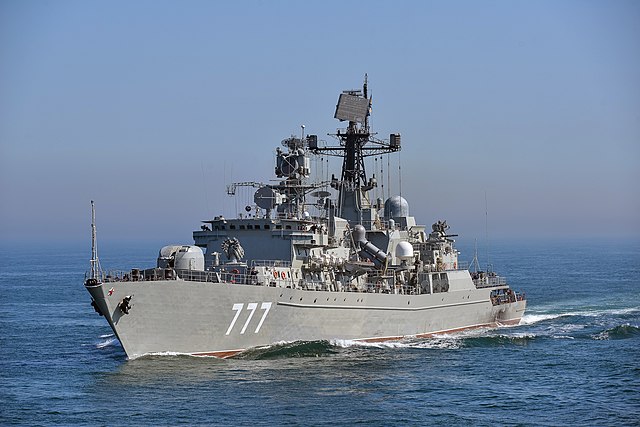
An ambitious late cold war successors to the Krivak, larger and with more capabilities. The program was cancelled at the fall of the Soviet Union, with only two completed, both active today, modernized: Neustrashimy, Yaroslav. See the full specs..
 Gepard-class frigate
Gepard-class frigate
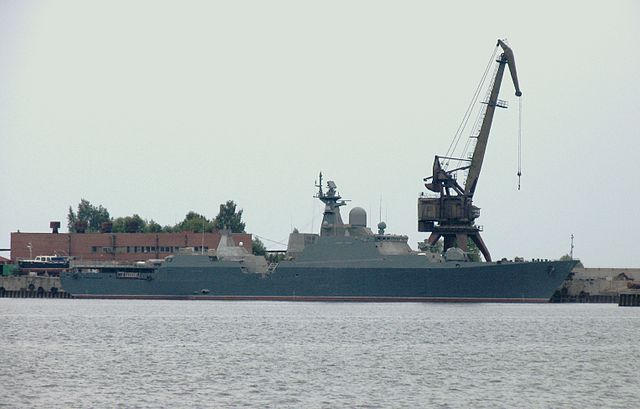
These Frigates are listed there only because their genesis started during the cold war, but they were laid down just after the fall of USSR. They were meant to be a replacement for the Koni class ships, as a mid-range, versatile and tailored for export. Project 1166.1 were also tailored for ASW warfare (in Soviet service) as replacement for the Grisha and Parchim-class corvettes. The lead ship, Yastreb (Hawk), was laid down at the Zelenodol’sk Zavod shipyard at Tatarstan in 1991, launched in July 1993, and completed by late 1995, but suspended due to lack of funds.
In Russian service, commissioned in 2002 she was eventually Renamed Tatarstan and became the flagship of the Caspian Flotilla.
Two sister ships, Albatross and Burevestnik (Storm Petrel) saw the construction suspended and resumed as of 2012. Nowadays only Tararstan and Dagestan (ex-Albatross) are in service, in the Caspian sea. Until the fall of USSR the Caspian sea naval force was reduced due to neghbouring countries being part of the USSR. After the collapse and setup of the new Russian federation, the Caspian sea became a border sea with potentially hostile countries (Kazakhstan, Uzbekistan, Turkmenistan and Iran) and therefore the local fleet was reinforced.
We will return on the matter in a dedicated post on modern Russian frigates. The type was also exported: Four ships were in construction for Vietnam since 2007, also at Zelenodolsk Shipyard, active from 2011 (Dinh Tien Hoang class). Two more were planned HQ-017 and 018, but construction has yet to start.
 Admiral Gorshkov (Project 22350) class Frigate
Admiral Gorshkov (Project 22350) class Frigate
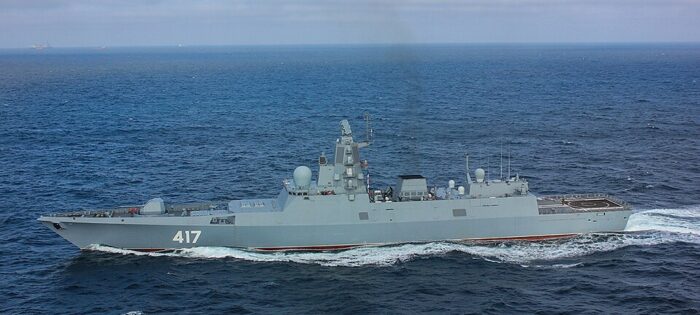
Three active ships, replacing the Krivak rather than Neustrahimmy clas, cobsidered too costly. They have almost double the tonnage of the Krivak and are well armed, continuing this tradition of versatile, rather than ASW-specialized vessels. Today they are the mainstay of the Russian Frigate Force:
Project 22350 guided-missile frigates were designed by the Severnoye Design Bureau, built by Severnaya Verf in Saint Petersburg. Roughly 10 ships were planned by around 2027–2030.
Lead ship, Admiral Gorshkov, commissioned July 2018 after prolonged trials and delays in shipboard systems delivery. Second ship, Admiral Kasatonov, entered service around 2020; subsequent vessels include Admiral Golovko (first with regular Tsirkon capability) and Admiral Isakov commissioned into Pacific Fleet in 2024. As of 2025, at least three ships active, with several more under construction or planned—including hull numbers 929–932—alongside continuation of Project 22350M (“Super Gorshkov”) with enhanced VLS and armament.
Specifications:
Displacement 4,550 t standard, 5,400 t full load for 135 x 16 x 4.5 m
Propulsion: CODAG system: 2 × 10D49 diesels (5,200 shp each) + 2 × M90FR gas turbines (27,500 shp each): 65,400 shp
Speed & Range: 29.5 knots, range 4,850 nmi at 14 kn, endurance 30 days. Crew 210 personnel
Sensors: Air search radars 5P‑27 Furke‑4 and 5P‑20К Poliment active phased‑array, Surface search: 34K1 Monolit, Artillery fire-control radar: 5P‑10 Puma, Sonar suite: Zarya‑M hull sonar and Vinyetka towed array. Combat management: Sigma‑22350 system, supplemented by Prosvet‑M EW suite and countermeasures like Filin and decoys
Armament: 130 mm A‑192M naval gun, 2× Palash systems with dual‑barrel 30 mm Gatling guns and Sosna‑R SAM pods. 16-cell 3S‑14 UKSK VLS for Kalibr, Oniks, Tsirkon hypersonic, and Otvet ASW missiles, 32-cell Poliment‑Redut VLS for 9M96 family and 9M100 surface‑to‑air missiles. Torpedoes: 2 × 4-tube Paket‑NK system for anti-submarine and anti-torpedo roles. Helicopter: Hangar and flight deck support one Ka‑27 series helicopter (up to 12 t).
Project 22350M (“Super Gorshkov”):
An upgraded variant featuring larger hull (~7,000–8,500 t), expanded missiles capacity (up to 64 UKSK VLS cells), and improved air-defense (potentially ~100 Redut missiles onboard). First of this subclass expected to be laid down around 2024, with a planned production run of 12 ships.
Read More/Src
Books
Links
https://en.wikipedia.org/wiki/Russian_Navy
https://commons.wikimedia.org/wiki/Category:Naval_ships_of_the_Soviet_Union

 Latest Facebook Entry -
Latest Facebook Entry -  X(Tweeter) Naval Encyclopedia's deck archive
X(Tweeter) Naval Encyclopedia's deck archive Instagram (@navalencyc)
Instagram (@navalencyc)





 French Navy
French Navy Royal Navy
Royal Navy Russian Navy
Russian Navy Armada Espanola
Armada Espanola Austrian Navy
Austrian Navy K.u.K. Kriegsmarine
K.u.K. Kriegsmarine Dansk Marine
Dansk Marine Nautiko Hellenon
Nautiko Hellenon Koninklije Marine 1870
Koninklije Marine 1870 Marinha do Brasil
Marinha do Brasil Osmanlı Donanması
Osmanlı Donanması Marina Do Peru
Marina Do Peru Marinha do Portugal
Marinha do Portugal Regia Marina 1870
Regia Marina 1870 Nihhon Kaigun 1870
Nihhon Kaigun 1870 Preußische Marine 1870
Preußische Marine 1870 Russkiy Flot 1870
Russkiy Flot 1870 Svenska marinen
Svenska marinen Søværnet
Søværnet Union Navy
Union Navy Confederate Navy
Confederate Navy Armada de Argentina
Armada de Argentina Imperial Chinese Navy
Imperial Chinese Navy Marinha do Portugal
Marinha do Portugal Mexico
Mexico Kaiserliche Marine
Kaiserliche Marine 1898 US Navy
1898 US Navy Sovietskiy Flot
Sovietskiy Flot Royal Canadian Navy
Royal Canadian Navy Royal Australian Navy
Royal Australian Navy RNZN Fleet
RNZN Fleet Chinese Navy 1937
Chinese Navy 1937 Kriegsmarine
Kriegsmarine Chilean Navy
Chilean Navy Danish Navy
Danish Navy Finnish Navy
Finnish Navy Hellenic Navy
Hellenic Navy Polish Navy
Polish Navy Romanian Navy
Romanian Navy Turkish Navy
Turkish Navy Royal Yugoslav Navy
Royal Yugoslav Navy Royal Thai Navy
Royal Thai Navy Minor Navies
Minor Navies Albania
Albania Austria
Austria Belgium
Belgium Columbia
Columbia Costa Rica
Costa Rica Cuba
Cuba Czechoslovakia
Czechoslovakia Dominican Republic
Dominican Republic Haiti
Haiti Hungary
Hungary Honduras
Honduras Estonia
Estonia Iceland
Iceland Eire
Eire Equador
Equador Iran
Iran Iraq
Iraq Latvia
Latvia Liberia
Liberia Lithuania
Lithuania Mandchukuo
Mandchukuo Morocco
Morocco Nicaragua
Nicaragua Persia
Persia San Salvador
San Salvador Sarawak
Sarawak Uruguay
Uruguay Venezuela
Venezuela Zanzibar
Zanzibar Warsaw Pact Navies
Warsaw Pact Navies Bulgaria
Bulgaria Hungary
Hungary

 Bundesmarine
Bundesmarine Dutch Navy
Dutch Navy Hellenic Navy
Hellenic Navy Marina Militare
Marina Militare Yugoslav Navy
Yugoslav Navy Chinese Navy
Chinese Navy Indian Navy
Indian Navy Indonesian Navy
Indonesian Navy JMSDF
JMSDF North Korean Navy
North Korean Navy Pakistani Navy
Pakistani Navy Philippines Navy
Philippines Navy ROKN
ROKN Rep. of Singapore Navy
Rep. of Singapore Navy Taiwanese Navy
Taiwanese Navy IDF Navy
IDF Navy Saudi Navy
Saudi Navy Royal New Zealand Navy
Royal New Zealand Navy Egyptian Navy
Egyptian Navy South African Navy
South African Navy






























 Ukrainian Navy
Ukrainian Navy dbodesign
dbodesign